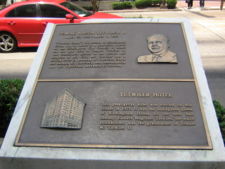Tutwiler Hotel
The original Tutwiler Hotel was a 13-story brick and limestone luxury hotel on the southeast corner of 5th Avenue North and 20th Street in downtown Birmingham. It was constructed in 1914 by a group of local investors. It closed in 1972 and was demolished in 1974, Another Tutwiler Hotel, named for the original, opened in 1986 in the former Ridgely Apartments.
Conception
In 1913, George Gordon Crawford, president of Tennessee Coal, Iron and Railroad Company, complained to Robert Jemison, Jr. that when friends and officers from U.S. Steel came into town they had no decent place to stay.
Jemison soon learned that Harvey G. Woodward was hoping to sell a lot on the southeast corner of 5th Avenue North and 20th Street, a lot originally bought to prevent the construction of a new office building that would have competed with Woodward’s downtown properties. Immediately, Jemison challenged Crawford to join him in building a luxury hotel in Birmingham.
While Crawford assumed the duties of president of the new company, Jemison and W. P. G. Harding, president of the First National Bank, set out to secure the mortgage for the hotel. At Harding’s suggestion, they approached Major Edward M. Tutwiler, who had just sold his interest in the Tutwiler Coal and Coke Company and was about to embark on a tour of South America with his wife.
Major Tutwiler tentatively agreed to underwrite the first mortgage bonds. When he returned from South America, he learned from Jemison that the option had been exercised and New York architect W. L. Stoddart was already working on plans for the new hotel in collaboration with local architect William Leslie Welton. He and hotelier Robert R. Meyer made trips to hotels in other cities to study their best features and worst mistakes. The result blended ideas from the Slaten Hotel in Cincinnati, the Blackston Hotel in Chicago, and the Vanderbilt and McAlpin Hotels in New York City.
Congratulating Jemison for their progress, he suggested that, if the other investors were agreeable, the hotel be named "The Tutwiler". They were, and construction proceeded. The United Hotels Company of Niagara Falls agreed to lease and operate the hotel if it were completely finished out and serviced by heat and power.
According to one story, the building's excavation revealed an underground stream, requiring the addition of large steel beams spanning across the opening at enormous extra cost. In order to raise the entire $1.6 million needed to complete the building, the officers took out second and third mortgages - even while the specter of war was looming. United spent another $400,000 furnishing the hotel.
Opening
The new hotel opened its doors in June 15, 1914. Easter lilies filled the lobbies, and leading citizens turned out in formal attire to see the newly proclaimed “Grand Dame of Southern Hotels.” Promotional brochures announced that the Tutwiler “[e]mbodies every advanced thought [that] architectural ingenuity, aided by skilled labor, has so far devised… consisting of 325 rooms, equipped with bath or shower, fire alarms and telephone.” Rates ranged from $1.50 for a single room without bath to $6.00 for a double room with bath.
For the next 60 years, The Tutwiler was a hub of Birmingham business, social, and political circles, playing host to hundreds of celebrities, politicians, and dignitaries. A reviewing stand for the largest annual Veterans Day Parade in the country was erected outside the Tutwiler. Charles Lindbergh held a 1927 press conference in its Louis XIV Suite. Tallulah Bankhead threw a rousing post-wedding party in its Continental Rooms and President Warren G. Harding slept at The Tutwiler the night before he helped celebrate Birmingham’s semicentennial.
Dinkler
In 1929 United dropped the Tutwiler lease and the hotel was operated by Lewis J. Dinkler of Atlanta as the Dinkler-Tutwiler Hotel. He marketed alongside his other properties, the Ansley Hotel in Atlanta, the Jefferson Davis Hotel in Montgomery, and the Andrew Jackson Hotel in Nashville.
Over the years, distinguished guests included Roy Rogers and Dale Evans, First Lady Eleanor Roosevelt, Rocky Marciano, Babe Ruth, opera star Mary Garden, Jeanette McDonald and Nelson Eddy, Walter Pidgeon, Dr Norman Vincent Peale, and Vice President Hubert Humphrey.
Hoffman
In 1945 Birmingham's Realty Mortgage Company announced that it intended to buy the hotel and add a 168-room motel and swimming pool on the adjacent lot. They later withdrew the offer and the hotel was eventually purchased by J. Henry Hoffman of Philadelphia, Pennsylvania in February 1956 for $1.25 million.
Great Southern

In June 1967 the Birmingham-Hoffman Corporation sold the Tutwiler to the local Great Southern Investment Corporation for an estimated $1.7 million. James P. Paris, head of the investment group, announced that they expected to spend up to $1 million more to renovate all guest rooms, banquet spaces, cocktail lounges, restaurants, and lobbies in the building.
The hotel closed for good just five years later, on April 1, 1972. On January 27, 1974 the Tutwiler was imploded to make way for the First Alabama Bank building.
Reincarnation
In 1985 it was decided to convert the Ridgely Apartments building, which had also been built by Robert Jemison Jr. in 1913 and was owned by the Tutwiler family, into a new luxury hotel named after the original. In 1986 renovations of the building were completed and the new Tutwiler opened to guests.
References
- "Tutwiler will get $1 million face lifting by new owners." (June 1967) Birmingham News.
- Bruer, Frank (June 1967) "Tutwiler Hotel has sparkled 53 years." Birmingham News.
- Tutwiler Hotel, Birmingham on Emporis.com
- Bryant, Walter (November 27, 1975) "Underground river helped shape city". Birmingham News.
External links
- 1955 photograph of the Tutwiler Hotel by Charles Preston at the Birmingham Public Library Digital Collections
- The Tutwiler website for the current Tutwiler Hotel
